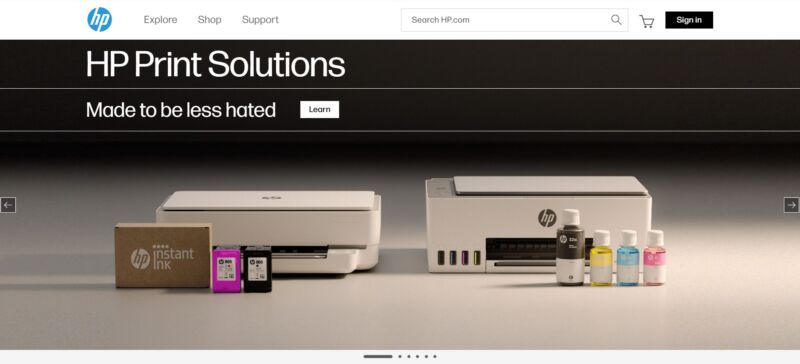
HP knows people have grown to hate printers. It even knows that people hate HP printers. But based on a new marketing campaign the company launched, HP is OK with that—so long as it can convince people that there are worse options out there.
The marketing campaign hitting parts of Europe aims to present HP as real and empathetic. The tagline “Made to be less hated” seems to confess people’s frustration with printers. But HP’s a top proponent of the exact sort of money-grabbing, disruptive practices that have turned people against printers.
When did HP printers become “less hated”?
Three short HP video ad campaigns detailed by Marketing Communication News include one with a customer supremely frustrated with his printer’s low ink warning. He kicks his hardware off the table before words appear saying, “No more low ink with HP ink solutions.” Another HP video brags of “no more installation fails” and points to HP’s Smart app. Both of these claims fall apart with a look at HP’s recent and poorly executed firmware rollouts.
HP’s approach to pushing ink and toner sales is controversial. HP has infamously bricked functioning ink and toner cartridges because they weren’t HP brand. Dynamic security, as HP calls it, has resulted in numerous class-action lawsuits, and HP has paid out settlements, including in the US, Europe, and Australia.
Despite this, HP has continued to roll out sudden disruptive firmware updates to add dynamic security to additional printer models. That happened earlier this year, when users reported that their previously functioning third-party ink wouldn’t work in their HP printer anymore. HP didn’t explain why dynamic security was suddenly necessary, nor did it warn users relying on their printers for work and other critical matters.
HP says it uses dynamic security “to protect the quality of our customer experience, preserve the integrity of our printing systems, and protect our intellectual property.” HP introduced dynamic security in 2016 as the print industry declined, which is 41 percent of HP’s consumer business.
The HP+ program is another way HP tries to force customers to use only HP-branded ink and toner, and there have been complaints about HP not allowing users to deactivate HP+ after buying a printer with it.
Even those who leave the US can’t escape HP printers’ chains. Some HP printers are region-locked, and getting out of those binds is extremely complicated, as The Verge has detailed.
In addition to firmware suddenly bricking costly, functioning ink cartridges, HP botched a firmware update earlier this year in such a way that printers were bricked for weeks.
In trying to frame itself as understanding, HP fails to address its customers’ struggles. Instead, it seems focused on maintaining the status quo in a declining business—largely by trapping customers into maintaining business with HP.
Lock-in love affair
HP’s having a love affair with vendor lock-in. Lock-ins, whether it be with printer companies, mobile or Internet providers, cable companies, or the local gym, often wind up forcing customers to spend money in ways they don’t want to.
Still, this business practice is something that HP speaks proudly of. CFO Marie Myers highlighted the business value of constraining customer choice at the UBS Global Technology conference for investors this week.
“We absolutely see when you advance a customer from that pure transactional model … whether it’s [to] Instant Ink, [HP’s monthly ink subscription program], plus adding on that paper, we sort of see a 20 percent uplift on the value of that customer because you’re locking that person, committing to a longer-term relationship,” Myers said, according to The Register.
The executive added that HP’s “really proud” about raising “the range on our print margins” through “bold moves and shifting models.” As customers across offices, homes, and social media declare their hate for HP printers, HP’s printing division operating margins have increased. The division ended HP’s fiscal year 2016 with 14 percent operating margins, compared to 18.9 percent in FY 2023.

